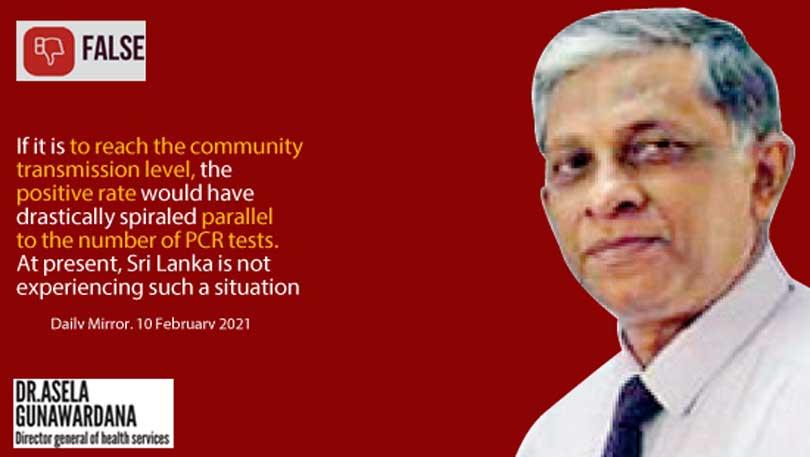11 Mar 2021 - {{hitsCtrl.values.hits}}

 In his statement, the Director General (DG) of Health Services Dr. Asela Gunawardana states that if COVID-19 reaches community spread, then the positive rate will spike up as an indication. He concludes by this criteria that Sri Lanka does not have community spread.
In his statement, the Director General (DG) of Health Services Dr. Asela Gunawardana states that if COVID-19 reaches community spread, then the positive rate will spike up as an indication. He concludes by this criteria that Sri Lanka does not have community spread.
In November 2020, FactCheck assessed a statement by the Chief Epidemiologist of the Ministry of Health and concluded that Sri Lanka had, even then, reached community spread, based on globally accepted criteria. This fact check will assess whether the current claim, despite not fitting any known definitional criteria, could yet have some merit on an empirical basis.
To assess the claim, FactCheck consulted the WHO’s global COVID-19 updates from March 2020 to February 2021 and global COVID-19 testing data from Our World in Data. As of 10 February 2021, 74 countries were classified as having community spread. Of these, FactCheck evaluated data on the 24 countries for which (i) comprehensive testing data was available; and (ii) in the week preceding classification as community spread, the number of tests per day was at least 4,000.
An increase in the positive rate (the ratio of cases to tests) that the DG refers to is the same as a decline in the test-to-case ratio (TCR). Since TCR is the more commonly reported metric globally, this fact check will use it, rather than the positive rate, to assess the DG’s claim.
For the 24 countries assessed, the 30-day average TCR ranged from a minimum of 2.79 (Mexico) to a maximum of 107.68 (Ethiopia), with a mean of 29.9. On 10 February 2021, Sri Lanka’s average TCR was 27.25 – this puts Sri Lanka very close to the global mean for countries at the point they were classified as ‘community transmission’. The DG’s claim implies that the TCR must “drastically” decline for the transmission level to be upgraded to ‘community transmission’. However, globally this is not the case. In 8 of the 24 countries assessed, the TCR actually increased in the month leading up to the classification change – this means that it takes more tests to identify a positive case. This does not necessarily mean that the spread is reducing; it can also mean that a country’s testing regime has improved. In the month preceding 10 February 2021, Sri Lanka’s TCR decreased by 2.03.
In terms of TCR, Sri Lanka is worse off than at least nine countries at the point they were classified as ‘community transmission’. Its decline in TCR is higher than at least 11 countries. These numbers means that countries like Finland, Hungary, Lithuania and Luxembourg, were all actually doing better than Sri Lanka in terms of their both their TCR numbers and TCR trend at the point at which their COVID-19 spread was classified as ‘community transmission’.
Therefore, in addition to deviating from any known definition on the classification of ‘community transmission’, the DG’s claim is also contrary to empirical evidence. Hence, we classify the DG’s statement as FALSE.
Originally published on @factchecklka on 19 November 2018.
FactCheck is a platform run by Verité Research.
For comments, suggestions and feedback, please visit www.factcheck.lk.
22 Dec 2024 6 hours ago
22 Dec 2024 7 hours ago
22 Dec 2024 9 hours ago
22 Dec 2024 9 hours ago
22 Dec 2024 9 hours ago